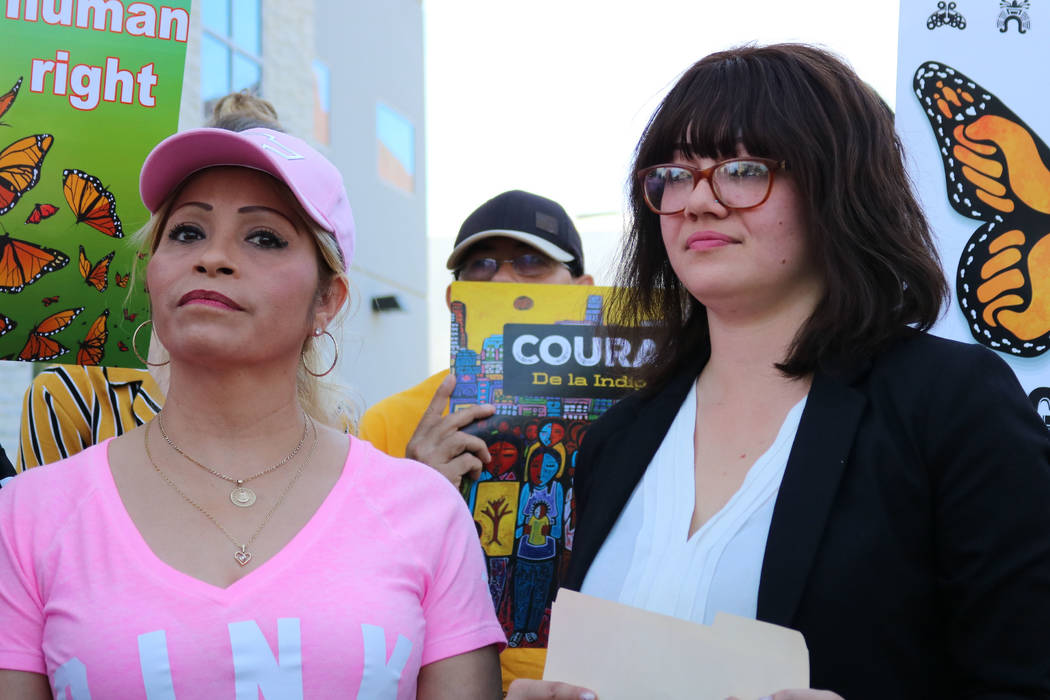UNLV lawyer pursues immigrant separated from child through ICE maze

Representing undocumented immigrants caught up in President Donald Trump’s “zero tolerance” policy can present many unexpected challenges, including finding your client within the sprawling U.S. Immigration Customs and Enforcement detention system.
Which explains why UNLV immigration attorney Laura Barrera found herself bouncing down a rural Texas highway on Thursday, trying to find out what had become of the man who had called her about two months earlier from ICE’s Henderson Detention Center seeking help reuniting with his 5-year-old daughter, who was being held separately by ICE.
“I was a little hesitant coming here,” Barrera told a reporter as she rolled along a rural road, warning that she might lose cell service at any moment. “At the same time, in order to be able to work on his case, I need to talk not only to him but the ICE officer in charge of his case. And they (ICE) are not really answering the phone.”
Barrera’s client is one of at least two adult immigrants confirmed to have been detained in Henderson after being separated from their children at the border as part of the Trump administration’s latest border crackdown, which is aimed at deterring immigrants from entering the country illegally. In response, a federal district judge in San Diego ordered the administration to abandon the family-separation policy and gave it until Thursday to reunite the more than 2,500 families that already had been divided.
Barrera said she suspects others have been sent to Henderson’s facility, presumably because beds are available there, though she and other lawyers at UNLV’s Immigration Clinic had not been able to confirm that.
A whirlwind of activity
The efforts to reunite parents and children produced a whirlwind of activity as ICE and other government departments scrambled to meet the deadline.
Barrera was told by Las Vegas ICE agents that her client, whom she declined to name to protect his privacy and safety, had been moved to the Port Isabel detention center at the southeast tip of Texas. She said she learned that only when she began making inquiries after the man disappeared without warning about a week ago.
But when she finally arrived in Port Isabel on Thursday, authorities there said the man had been transferred again, likely to a residential center for immigrant families in Karnes County, southeast of San Antonio. So Barrera climbed back in her car and set off on the 3½-hour drive to get there.
As she drove, Barrera said she was having a hard time wrapping her head around the fact that she was even there, chasing after her client. But if she didn’t go, who would represent him?
“It’s a huge access-to-justice issue when someone succeeds in finding an attorney, and then they’re taken away from their attorney,” she said, referring to the limited number of qualified lawyers who provide “pro bono,” or free, counsel to immigrants. “There are a lot of parts of our immigration system that I think are kind of inhumane … but despite doing this work, I’m still having a hard time believing this is happening.”
Another shock
Barrera got another shock when she arrived at the Karnes County facility and was told that her client was not there and never had been.
An agent at the detention center’s check-in desk told Barrera that she would have to drive back to Port Isabel.
She pushed back. “Basically, I was like, ‘I’m not going to go back there because he’s not there,’” Barrera said.
Finally, the agent made a call and then handed her a Post-It note with an address scribbled on it.
Barrera jumped back into her rental car and hit the road again.
On Friday morning, she confirmed she had finally managed to locate her client late Thursday and determine that he had been reunited with his daughter. Both were staying at a home provided by a local charity, she said.
Michael Kagan, director of the UNLV Immigration Clinic, compared the administration’s immigration moves with government actions he saw when working in the Middle East before moving to Las Vegas.
“I’ve never dealt with anything like this,” he said. “This was the sort of thing I’d expect of the Egyptian government. It’s not the sort of thing I’d expect of the U.S. government in the past.”
‘No right to an attorney’
But Mark Krikorian, executive director at the Center for Immigration Studies, a think-tank that advocates for limiting immigration, said there’s no legal responsibility for the government to provide undocumented immigrants with public representation.
“As far as immigration issues go, that’s a civil matter,” Krikorian said. “After all, an American in divorce court or bankruptcy court has no right to an attorney.”
When Barrera finally tracked down her client, she learned he’d been released from Port Isabel early Wednesday after about a week at the facility. He is required to check in with ICE in about a month, giving Barrera time to sort through the documents in his case to prepare his defense.
Meanwhile, Barerra said her client’s wife is back at their home in the Northern Triangle of Central America, which consists of Guatemala, Honduras and El Salvador.
About two weeks ago, Barrera said her client received a ruling from a Las Vegas immigration judge that would prevent ICE agents from immediately deporting him.
But given all that has transpired since then, she said she needs to circle back to see where things stand.
“I need to talk to ICE,” she said.
As she sat and explained the situation to her client as best she could Thursday evening, his daughter, dressed in a pink skirt, played with a pair of sunglasses and tugged at her father to get his attention.
“I know she was just really excited to be with him again,” Barrera said, adding that after two months apart, she could see the man’s stress melt away ever so slightly with his daughter by his side.
Contact Jessie Bekker at jbekker@reviewjournal.com or 702-380-4563. Follow @jessiebekks on Twitter.













